Mistake Proofing is a continuous improvement methodology used to drive quality by preventing errors from occurring within a process.
Mistake proofing is achieved by identifying potential sources of mistakes and then implementing safeguards in order that such mistakes can be prevented. For example, by implementing limit switches on equipment within a manufacturing environment, we can be confident of achieving the required tolerances.
In today’s article, we’ll be discussing Mistake Proofing, its benefits and how it can be applied to your business. We’ll be covering:
- What is Mistake Proofing
- Mistake Proofing / Error Proofing / Poke Yoke
- How do we get an understanding of what mistakes can occur?
- Where is Mistake Proofing used?
- What are the types of Mistake Proofing
- What are the rules of Mistake proofing
- Examples of Mistake Proofing
- How to carry out Mistake proofing
- Benefits of Mistake Proofing
- Issues with Mistake Proofing
What is Mistake Proofing
While all businesses will aspire to be defect-free, issues do happen.
When they occur, they can drive a range of issues from
- Impact to Quality
- Impact to customer
- Cost (due to correction)
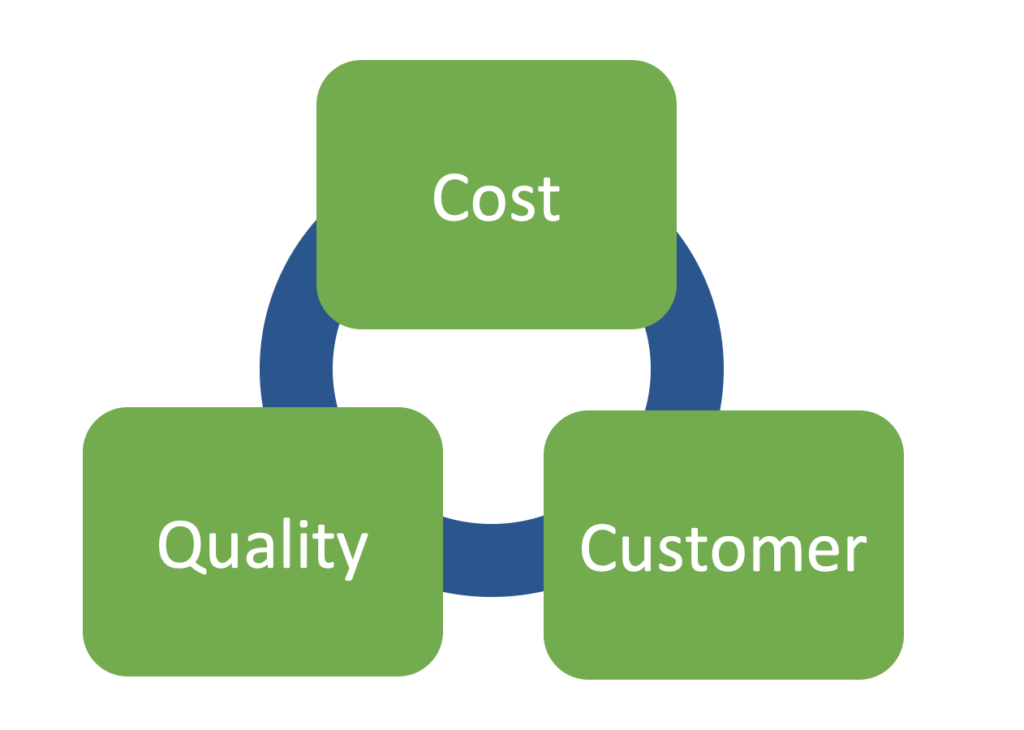
As a result, there is benefit in investing in systems that drive the avoidance of mistakes. This is termed mistake or error-proofing.
Mistake proofing is a methodology that businesses can use to understand sources of, and prevent, mistakes from occurring by targeting the root cause of issues.
The primary goal of mistake-proofing should be to eliminate, not reduce, the root causes of errors and defects by making it difficult for mistakes to occur in the first place.
While mistake-proofing can be applied to most processes, you will find that it is implemented where:
- The process has a history of errors, defects, or quality issues or where opportunities exist to implement simple changes that drive the avoidance of errors.
- Processes are highly complex or high-risk, often where mistakes or errors can impact safety or result in significant quality issues.
Mistake proofing is a continuous improvement tool and, as such, should be seen as an important component of quality management.
Whilst it can be used in isolation, it is usually used alongside complementary methodologies such as Lean or Six Sigma.
Effective mistake-proofing requires
- A thorough understanding of the process being analyzed,
- Potential sources of error.
- Backing by the organization to implement required changes
Mistake proofing can be applied to a wide range of processes, including manufacturing and services and can be adopted by the whole organization involving workers across functions in both identifying and solving process challenges.
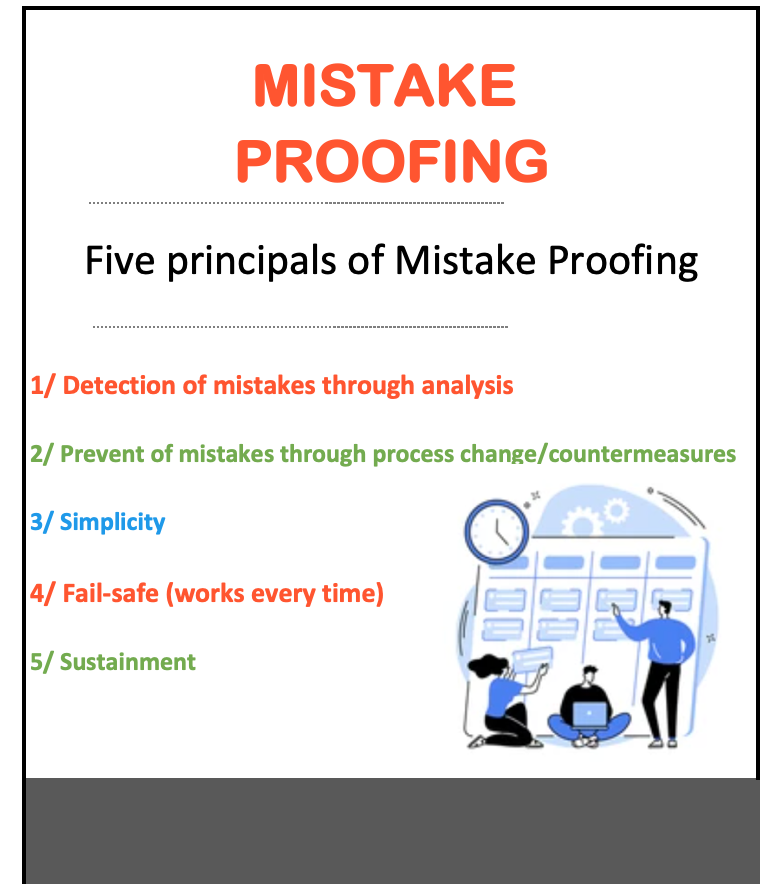
Mistake proofing has five key principles
- Detection of mistakes through analysis
- Prevention of mistakes through process change and countermeasures
- The simplicity of process change
- Fail-safe (works every time)
- The need to be sustained
There are three common types of mistake-proofing:
- Contact method: The use of sensors (or other devices) to detect and prevent errors from occurring.
- Fixed-value method: The setting of limits or parameters that prevent errors from occurring. For example, the use of templates to ensure parts are assembled correctly.
- Motion-step method: Visual or audible cues to guide workers through a process. In its simplest form, a checklist through to more complex assembly tools like error alerts or audible/visual warnings.
Mistake Proofing / Error Proofing / Poke Yoke
There are several descriptions, which are often used interchangeably for identifying and preventing issues within processes; these include:
- Mistake proofing – used to describe the overall methodology
- Error proofing – used to describe techniques that prevent errors
- Poka-yoke – Japanese phrase used to describe techniques such as designing processes and tools in a way that makes it impossible for errors to occur
How do we get an understanding of what mistakes can occur?
A fundamental element of mistake-proofing is the need to understand how mistakes occur. To do this we can use various methods to do this, including:
- Observing the process,
- Gathering data,
- Reviewing process with stakeholders.
The output of this should be input into process changes that should be made to prevent mistakes.
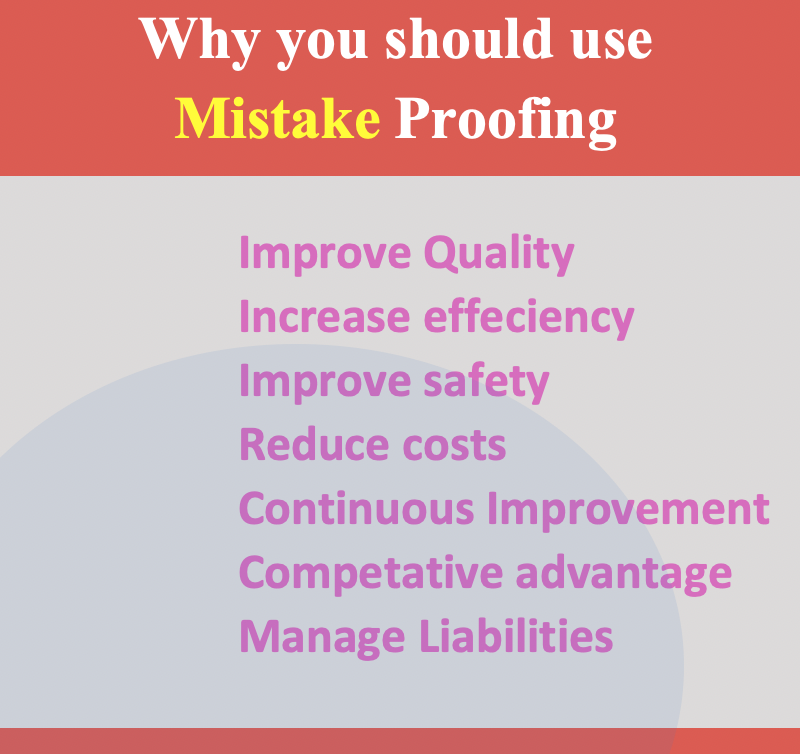
Where is mistake proofing used?
Mistake proofing is used in a wide variety of organizations and industries, whether large or small.
It’s commonly used where there is an imperative for businesses to prevent mistakes in order for it to achieve high levels of quality and safety (for example, in pharmaceuticals and aerospace).
Here are some further industries where you’ll find mistake proofing commonly used:
- Manufacturing – Mistake proofing is commonly used; processes may include visual inspection tools, automated controls and or sensors (to ensure the correct positioning of components during production)
- Healthcare: Tools used include checklists, protocols, and automation.
- Service Industry: Used to prevent mistakes in transactions and customer service.
- Transportation – Including warning systems, safety protocols, and automated controls.
Mistake-proofing can be adapted to most industrial sectors with a broad array of tools and methods.
Why use Mistake Proofing
There are many reasons for using mistake proofing as a method to reduce errors and improve quality – these include
- Improving quality – Mistakes impact quality; reducing the likelhood of errors and defects can increase levels of quality and enable the business to meet customer expectation.
- Increased efficiency – using tools and methods promoted by mistake proofing, errors are minimized, decision-making improved and rework reduced.
- Improved safety – Mistake-proofing can help businesses improve safety and reduce accidents and hazards.
- Reduce costs – reduce costs associated with mistakes such as rework, scrap/waste, and productivity loss.
- Continuous improvement: Mistake-proofing is an important step in building a culture of continuous improvement through process review and modification.
- Competitive advantage – Mistake proofing can build competitive advantage in two ways, firstly through innovative production methods and secondly by building a reputation for quality.
- Corporate liability – Mistake proofing can help organizations reduce liability by reducing and/or preventing mistakes that may result in legal or regulatory compliance challenges.
What are the rules of mistake proofing
Shigeo Shingo, the Japanese industrial engineer who helped develop the Poke Yoke system as part of the Toyota production system, defined certain “rules” for mistake proofing – these included:
- The purpose of mistake-proofing is to eliminate errors
- Mistake proofing requires a focus on the process (not the operator)
- Implement mistake-proofing as close to the source of the problem as possible
- Ensure mistake proofing is simple to understand and implement
- Mistake proofing should be consistent (i.e. work every time)
- Ensure that mistake proofing detects errors, not only prevents them.
- The process should stop when an error occurs.
- Mistake proofing should be applicable to multiple situations.
- Mistake proofing should reduce the need for inspection
- Mistake proofing is not a one-off but should be continually assessed and improved
Examples of Mistake Proofing
Let’s look at some examples of mistake-proofing:

Sim Card – With a SIM card, mistake-proofing is incorporated into the physical design of the product. The SIM card has a specific design, resulting in it fitting only one way into the slot of the device that will utilize it. As a result, this design prevents incorrect installation.
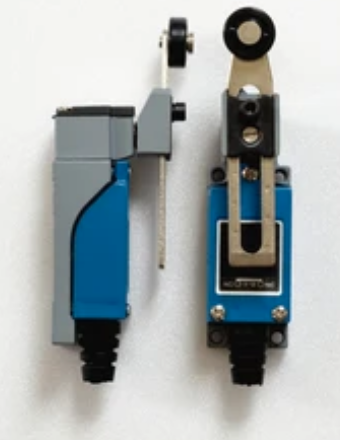
Limit switch on machinery – A limit switch is a component on many industrial machines utilized within production processes. Its purpose is to identify an object’s presence (or absence) in a specific location and signal to the machine to carry out a certain action (for example, a stop action where the component is misplaced).
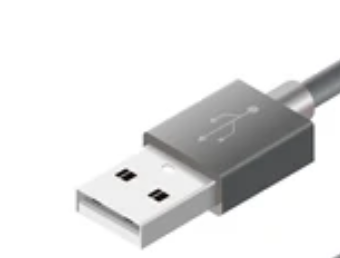
USB Plug – Mistake proofing is incorporated through its design, where the physical shape of the device prevents users from plugging it in the wrong way.

Labelling – The use of labelling is prominent in the use of drugs and associated pharmaceuticals. In this scenario, labelling provides essential information about a product, including dosage and potential side effects. By utilizing labelling as a mistake-proofing system, healthcare professionals reduce the likelihood that errors will occur and safeguard patients.
How to carry out mistake proofing
Mistake proofing is a process in its own right and therefore requires the completion of several steps in order to implement it correctly – these include:
- Identify the process that requires mistake proofing – these might be where processes are mistake prone or where it is critical that errors must be avoided.
- Review current problems with the process and gain an understanding of the root cause of mistakes.
- Develop solutions that can be implemented and would result in the elimination of mistakes.
- Review solutions and carry out feasibility and impact assessments prior to selecting an appropriate candidate to deploy
- Carry out tests to ensure the revised process is effective and errors have been eliminated.
- Fully implement the mistake-proofing measure (this includes the deployment of revised process, tools/enablers (such as machinery or sensors) and training of users.
- Monitor the process changes to ensure effectiveness is as expected and ensure change is sustained and assessed as part of continuous improvement plans.
Benefits of Mistake Proofing
Mistake-proofing can provide a wide range of benefits, these – these include:
- Improved quality through reductions in mistakes.
- Improved customer experience due to improved quality of product or service
- Improved productivity and efficiency
- Reduced costs as a result of minimizing waste, rework, and scrap,
- Improved safety
- Improved job satisfaction
- Deployment of continuous improvement
Issues with Mistake Proofing
There are various challenges associated with using mistake proofing, which you should consider as part of your implementation – these include:
- Selecting a poor or inappropriate process change is unlikely to drive improvement. As a result, selecting just anything is not the answer – you need to select the right change.
- Operators may become over-reliant on mistake-proofing devices leading to errors if devices fail.
- Process changes are not accepted by the workforce, which results in resistance to change.
- The cost and complexity of proposed changes do not receive leadership support leading to a lack of funding.
- The chosen solution is overly complicated and difficult to implement and use.
- Implemented solution results in unintended consequences to other aspects of the process
- Training is inadequate, and users are not able to fully execute the changed process.
- The activity is seen as a one-off and is not regularly reviewed and sustained.
Summary
Mistake proofing is a widely used process that targets an improvement in quality and reduction in waste.
There are various methods of implementing the method and the methodology has several key characteristics, which include:
- It can be applied to most processes.
- It can improve both process quality and efficiency.
- It requires an understanding of the process that is being changed.
- It requires the development of safeguards that prevent mistakes, which are then applied to process
- It usually requires collaboration between process stakeholders in the development of process change.
- It is an ongoing process that requires sustainment.
- Can have a positive impact on the customer
While mistake-proofing is a valuable tool in improving business processes, it’s not without potential issues that should be considered during implementation. Perhaps the one that is often least considered is unintended consequences to other parts of the process or processes that link to the one being changed. This is why it’s imperative that proper analysis and testing are undertaken.
Perhaps you have implemented mistake-proofing or Poke Yoke? Maybe you have some valuable lessons you can share?
As ever, we’d love to hear your feedback; you can reach us in the comments section below or via Twitter.
